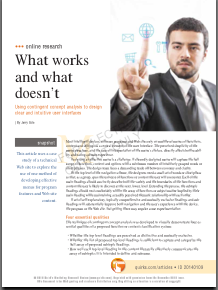“The joy of an early release lasts but a short time. The bitterness of an unusable system lasts for years.”– Anonymous
USER EXPERIENCE RESEARCH (UX)
Designs that Explain Themselves Designing an engaging and gracefully interactive user interface is hard work – but smoothing out the user experience doesn’t have to be. Like other forms of qualitative com-checks, a qualitative user experience assessment is a quick, inexpensive method for identifying – and correcting – the subtle miscues and hidden flaws in an otherwise great design. Through a series of short one-on-one interviews, using a prototype of your interface or a model of your device as the stimulus, we can quickly determine whether the target user understands the features, functions and controls offered by your design.
INVOLVE THE USER IN YOUR DESIGN PROCESS
Let the User Initiate the Exploration Our usability assessments are generally based on a pre-determined set of tasks and activities that we establish in consultation with you and your design team. The initial task, however, is to let the intended user follow their own instincts and see where they take us. Initially, we want to know:
- What (if anything) does the product or interface communicate to the user about its features, its functions and its basic “reason for being”?
- Is it engaging? Is it intriguing? Does it invite inspection, manipulation, or exploration?
This open-ended portion of the diagnostic interview reveals how quickly and how well a design both engages the user and telegraphs its principal functions.
TASKS WITH A PURPOSE
Working Through Your Checklist Once the user has conducted their initial exploration, we like to work through a set of tasks and activities that focus on specific aspects of usability and overall functionality that you and your design team have identified for that stage of the development process. With the introduction of each new task, we check whether:
- The interface or controls successfully communicate their intended functionality…
- The user is comfortable navigating through the task or controlling the device…
- The user can successfully play back any branding or product information that is seen as critical for product positioning or brand development.
- If appropriate to the level of finish and detail: whether the user found the experience to be appealing and personally rewarding.
MENUS THAT EXPLAIN THEMSELVES
Improving your UI’s Navigation System The perceived simplicity of the menu structure, and the ease of interpretation of the menu’s choices, directly affects both usability and ratings of user experience. We have developed a specific method for diagnosing and enhancing the interpretability and the functionality of multi-level menus of functions, features and content: Contingent Content Analysis (q-CCA). q-CCA will show you which elements of your navigation system are working and which areas need improvement. Learn more here…
FLEXIBLE & AFFORDABLE
A Research Design that Will Meet Your Needs We design our user experience assessments in direct consultation with the design team that is responsible for product development. Consequently, the work is tailored to address your specific concerns. Most assessments are conducted in person as relatively short, task-focused individual interviews. If your team prefers online testing, we can arrange that, as well. We have been able to provide valuable feedback on prototype designs with as few as 10-12 interviews with engaged category participants. And we can always do more if you have specific occupational or demographic segments you feel you need to cover.
VOTE EARLY. VOTE OFTEN.
Great Design is a Process, Not an Event Designing a great user interface is a process that can extend over months of hard work. The best time to begin improving usability and the eventual user experience is early in that extended design process: as soon as you have a rough prototype that your intended user can view and – preferably – manipulate.
Rough concepts and prototypes are great clay for molding delightful products and web sites. Don’t be afraid to work them over – early and often.
Our user experience assessments are but one part of our larger program of design support services. For additional information on how we might contribute to your program, please feel free to contact us.


